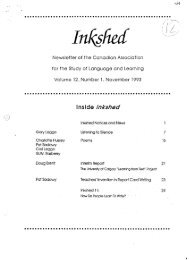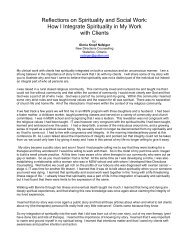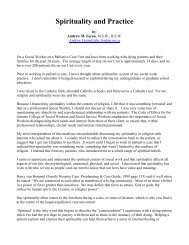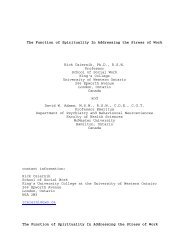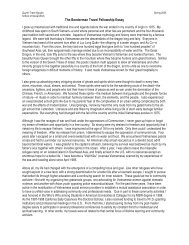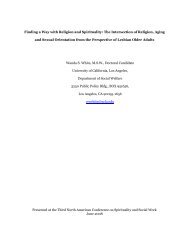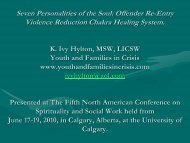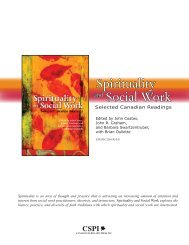The Wellness Wheel: An Aboriginal Contribution to Social Work
The Wellness Wheel: An Aboriginal Contribution to Social Work
The Wellness Wheel: An Aboriginal Contribution to Social Work
You also want an ePaper? Increase the reach of your titles
YUMPU automatically turns print PDFs into web optimized ePapers that Google loves.
and health. <strong>The</strong> well known Sioux Medicine man, Hehaka Sapa or Black Elk<br />
summarized the significance of the circle from his Native way of seeing:<br />
“All things created by the Great Power, He made in the shape of a circle.<br />
<strong>The</strong> sky is circular and I heard that the earth is round like a ball and the<br />
stars <strong>to</strong>o are round. <strong>The</strong> wind, in its greatest force, whirls. <strong>The</strong> birds<br />
make their nests in the form of a circle because they have the same<br />
religion as us. Our teepees were circular like the birds’ nests and were<br />
always arranged in a circle – the circle of the nation, a nest made of many<br />
nests where the Great Spirit wished that we protect and nurture our<br />
children” (cited in Sioui, 1989:13 – translated by M. Loiselle).<br />
<strong>The</strong> circle is also a reminder that important universal spiritual principles of<br />
behaviour such as love, kindness, patience, sharing, caring, honesty, truthfulness,<br />
trustworthiness, justice and humility are conducive <strong>to</strong> well-being and healthy<br />
relationships.<br />
<strong>The</strong> “circular nature [of the circle]” explains Mehl-Madrona (2003:99) “ensures<br />
that the whole is addressed [as it] informs us that all its elements are related <strong>to</strong> each<br />
other”. No single element at any level or of any kind can thus be treated in isolation.<br />
Mehl-Madrona (2003:99) further states that “action or work on one element leads <strong>to</strong><br />
potential change in any other element”. Systems theory also maintains that balance is<br />
essential <strong>to</strong> health (<strong>An</strong>drea, 1996) and stipulates that change in one component of a<br />
system has a rippling effect on all other components (Barker, 2003; Miley, K.K. O’Melia,<br />
M. and DuBois, B. 2004). Indeed, Duran & Duran confirm that the Native way of<br />
thinking and seeing the world is a systemic one. In addition <strong>to</strong> being systemic, the most<br />
relevant social work approach <strong>to</strong> health and wellness is a holistic one in <strong>Aboriginal</strong> view,<br />
since it identifies with an all-encompassing philosophy of life and addresses all aspects of<br />
the “self-in-relation” (Graveline, 1998:57). This view affirms, for example, that the fish,<br />
the lake and its entire surroundings, must all be treated equally in order for well-being <strong>to</strong><br />
8




